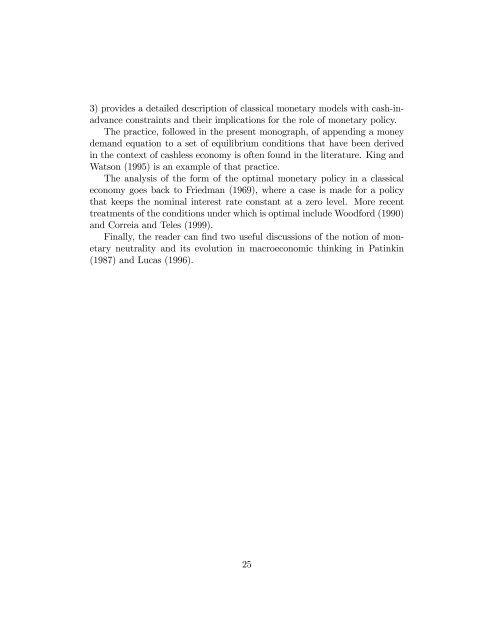Monetary Policy, Inflation, and the Business Cycle Chapter 2 A ...
Monetary Policy, Inflation, and the Business Cycle Chapter 2 A ...
Monetary Policy, Inflation, and the Business Cycle Chapter 2 A ...
You also want an ePaper? Increase the reach of your titles
YUMPU automatically turns print PDFs into web optimized ePapers that Google loves.
3) provides a detailed description of classical monetary models with cash-inadvance<br />
constraints <strong>and</strong> <strong>the</strong>ir implications for <strong>the</strong> role of monetary policy.<br />
The practice, followed in <strong>the</strong> present monograph, of appending a money<br />
dem<strong>and</strong> equation to a set of equilibrium conditions that have been derived<br />
in <strong>the</strong> context of cashless economy is often found in <strong>the</strong> literature. King <strong>and</strong><br />
Watson (1995) is an example of that practice.<br />
The analysis of <strong>the</strong> form of <strong>the</strong> optimal monetary policy in a classical<br />
economy goes back to Friedman (1969), where a case is made for a policy<br />
that keeps <strong>the</strong> nominal interest rate constant at a zero level. More recent<br />
treatments of <strong>the</strong> conditions under which is optimal include Woodford (1990)<br />
<strong>and</strong> Correia <strong>and</strong> Teles (1999).<br />
Finally, <strong>the</strong> reader can …nd two useful discussions of <strong>the</strong> notion of monetary<br />
neutrality <strong>and</strong> its evolution in macroeconomic thinking in Patinkin<br />
(1987) <strong>and</strong> Lucas (1996).<br />
25
















